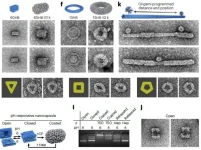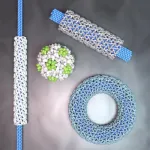(Press-News.org) COLUMBUS, Ohio – In a lab at The Ohio State University masquerading as a playroom, pairs of kids ages 8 to 12 participating in a study found a variety of toys and games to play with – as well as a mysterious file cabinet.
Inside one of the drawers of the unlocked cabinet were two disabled 9-mm handguns.
As they played in the room, nearly all the children eventually found the guns. But some kids in the study were much more likely to tell an adult they found a gun, less likely to touch the gun, and were less reckless if they did touch it – and they were the kids who had watched a one-minute gun safety video a week earlier.
The study may be the first to randomly assign some children to watch a gun safety video to determine if it had a protective effect, said Brad Bushman, co-author of the study and professor of communication at Ohio State.
“It was pretty remarkable to see that this one-minute video had such a powerful impact a week after the kids saw it,” Bushman said.
Bushman conducted the study with Sophie Kjærvik, a doctoral candidate in communication at Ohio State. Their results were published today (July 17, 2023) in the journal JAMA Pediatrics.
“Firearms are the leading cause of death for American children. These results point to a way that may help reduce the toll,” Kjærvik said.
The study involved 226 children whose parents or guardians gave permission for their participation. They were tested in pairs of kids who knew each other, including siblings, cousins and friends.
A week before the lab portion of the study, the children watched one of two one-minute videos created especially for the study. Both videos were of The Ohio State University police chief delivering a message in full uniform.
Half of the participant pairs saw the chief in a car safety video, while the other half saw her in a gun safety video. All of the kids watched the videos in their own homes.
A week later the children came to the lab and were told they could play with any of the toys and games in the room – including Legos, Jenga, nerf guns, foam swords and others – for 20 minutes.
The researchers and the children’s parents watched the children play from another room via a hidden camera.
Out of the 226 children, 216 (96%) opened the drawers of the filing cabinet and found the guns, which were disabled but rigged with a device that counted how often the kids pulled the trigger.
“Kids are naturally curious, so we were not surprised that they opened the drawers and found the guns,” Bushman said.
The researchers asked parents informally if they thought their kids would report the gun to adults and not touch the firearm.
“That’s what most parents in our study thought their child would do,” Kjærvik said. “But that is not what happened.”
Over half of the children (53%) touched the gun and fewer than a quarter (23%) told an adult.
But the key finding was the difference between those who watched the gun safety versus the car safety video.
Those who watched the gun safety video were more than three times more likely to tell an adult (34% vs. 11%) and less likely to touch a gun (39% vs. 67%).
Even those who did touch the gun were somewhat less reckless if they had watched the gun safety video. They held the gun for fewer seconds (42 versus 100 seconds), were less likely to pull the trigger (9% versus 30%) and pulled the trigger fewer times (four versus seven times).
“These are strong results, especially given that the video was so short and the children watched it a full week earlier,” Bushman said.
The video may have been effective because it featured an authority figure – a police chief – in full uniform. Previous research has shown that younger children find authority figures in uniforms to be especially persuasive.
In contrast, a firearm safety video by the National Rifle Association has been found to be ineffective, perhaps because it features a cartoon bird called Eddie Eagle rather than an authority figure, Bushman said.
Which video the children saw wasn’t the only risk factor linked to playing with the gun and not reporting it to adults. Being a boy was a risk factor, as was watching more age-inappropriate movies (which may include violence) and having an interest in guns.
Kids who had previously received firearms training were less at risk, as were those who had negative attitudes about guns.
Another protective factor was having a gun in the home, the study found.
“Research shows that gun owners talk to their children more often about gun safety than non-gun owners,” Kjærvik said.
The researchers also had children in the study watch a short clip of a violent PG-rated movie either with guns, or with the guns digitally removed, before they went into the playroom. The researchers had theorized that kids who watched the movie clips with guns would be more likely to play with the gun in the lab, but there was no effect.
“But the fact that kids who watched more age-inappropriate movies – which often include violent use of guns – were more at risk of playing with the gun makes us believe that media use does have an effect,” Bushman said.
Overall, the study provides a realistic and relatively easy way to help stem gun injuries and deaths among children, Kjærvik and Bushman said.
“We recommend that adults teach children about gun safety and reduce their exposure to age-inappropriate media,” the authors wrote.
END
Study finds how to reduce risk of kids playing with a found gun
Viewing a safety video reduced unsafe behavior with real firearm
2023-07-17
ELSE PRESS RELEASES FROM THIS DATE:
Trading sickness for health: Swapping brain cells points to new Huntington's therapies
2023-07-17
NNew research appearing in the journal Nature Biotechnology answers important questions about the viability of treatments that seek to replace diseased and aged cells in the central nervous system with healthy ones. Its findings have implications for a number of neurological and psychiatric disorders—including Huntington’s disease, amyotrophic lateral sclerosis (ALS), and schizophrenia—that have been linked to glia, a population of cells that support brain health and function.
“A broad variety of disorders we associate with neuronal loss now appear to be caused ...
Researchers craft ‘origami DNA’ to control virus assembly
2023-07-17
Griffith University researchers have played a key role in using DNA ‘origami’ templates to control the way viruses are assembled.
The global team behind the research, published in Nature Nanotechnology, developed a way to direct the assembly of virus capsids – the protein shell of viruses - at physiological conditions in a precise and programmable manner.
Dr Frank Sainsbury and Dr Donna McNeale from the Griffith Institute for Drug Discovery were part of the research team and said forcing viruses to assemble onto DNA folded into different shapes “like origami” was a question that this project answered.
“We achieved control over the virus protein ...
Cap top 20% of energy users to reduce carbon emissions
2023-07-17
Consumers in the richer, developed nations will have to accept restrictions on their energy use if international climate change targets are to be met, warn researchers.
The big challenge is to identify the fairest and most equitable way that governments can curtail energy use, a process known as energy demand reduction.
Writing in the journal Nature Energy, the research team - led by Milena Büchs, Professor of Sustainable Welfare at the University of Leeds - analysed several scenarios to identify a potential ...
Excess mortality with Alzheimer disease and related dementias as an underlying or contributing cause during pandemic
2023-07-17
About The Study: This study found that large increases in mortality with Alzheimer disease and related dementias as an underlying or contributing cause of death occurred in COVID-19 pandemic year 1 but were largely mitigated in pandemic year 2. The most pronounced declines were observed for deaths in nursing home/long-term care settings. Conversely, excess deaths at home and in medical facilities remained high in year 2.
Authors: M. Maria Glymour, Sc.D., of the Boston University School of Public Health ...
Comparison of history of present illness summaries generated by a chatbot and senior internal medicine residents
2023-07-17
About The Study: History of present illnesses generated by a chatbot or written by senior internal medicine residents were graded similarly by internal medicine attending physicians. These findings underscore the potential of chatbots to aid clinicians with medical documentation.
Authors: Ashwin Nayak, M.D., M.S., of Stanford University in Stanford, California, is the corresponding author.
To access the embargoed study: Visit our For The Media website at this link https://media.jamanetwork.com/
(doi:10.1001/jamainternmed.2023.2561)
Editor’s Note: Please see the article for additional information, including other authors, author contributions and affiliations, ...
Addressing adaptation inequalities in climate research
2023-07-17
A new study proposes ways to better incorporate adaptation in climate change research, addressing the uneven distribution of adaptation capacities and needs worldwide.
Research on adaptation to the risks posed by climate change has witnessed significant growth in the past decade, with increasing recognition of its urgency in policy agendas at the international, national, and local levels. Adaptation needs and capacities are not evenly distributed worldwide, with countries in the Global South generally experiencing the highest challenges. ...
Heading frequency and risk of cognitive impairment in retired male professional soccer players
2023-07-17
About The Study: The findings of this study suggest that repetitive heading during a professional soccer career is associated with an increased risk of cognitive impairment in later life. Further study is needed to establish the upper threshold for heading frequency to mitigate this risk.
Authors: Weiya Zhang, Ph.D., of the University of Nottingham in Nottingham, United Kingdom, is the corresponding author.
To access the embargoed study: Visit our For The Media website at this link https://media.jamanetwork.com/
(doi:10.1001/jamanetworkopen.2023.23822)
Editor’s Note: Please ...
COVID-19 vaccines saved dementia patients' lives in nursing homes
2023-07-17
Deaths among older adults with dementia fell starkly in nursing homes and long-term care centers after COVID-19 vaccinations became available, yet remained high for those living at home, according to a new study led by UC San Francisco.
The nationwide study published July 17, 2023 in JAMA Neurology, is the first to use data from 2019 to 2022 to quantify “excess” deaths – or those above what would have been anticipated had there been no pandemic – taking into account age, sex, racial and ethnic groups, as well as the settings where people died.
In the first year, there were 509,179 dementia-related ...
Reprogramming the shape of virus capsids could advance biomedicine
2023-07-17
Bioengineers have found a way to program the size and shape of virus particles by combining viral protein building blocks and templates made from DNA. The resulting nanostructures could have applications in vaccine development and transporting drugs inside the body.
Virus capsid proteins—the proteins that shield the genome of a virus—can be used to build precisely structured protein assemblies. Their shapes and geometry, however, depend largely on the virus strain. Reprogramming these assemblies, no matter the original ...
World-first clinical trial to help millions with penicillin allergies
2023-07-17
Penicillin allergy affects more than 25 million people in the United States (up to 1 in 10 Americans) and has been shown to lead to particularly poor health outcomes in pregnant women and surgical patients. It is also a public health threat, leading to antibiotic resistance and infections in hospitalized patients that can be life threatening.
Seventy-five% or more penicillin allergy labels come on by age 3 due to, for example, confusion with a viral rash. The majority of these rashes were never allergic, but the labels ‘stick’ into adulthood and carry many adverse consequences.”
Many low-risk patients with a penicillin allergy were able to have their ...
LAST 30 PRESS RELEASES:
Cannabis derivatives could provide new ovarian cancer treatments
Raising strong yeast as a petroleum substitute
Clues to the origin of hot Jupiters hidden in their orbits
Canada’s reduced pledge to Global Fund will impact domestic health
1 in 4 children with major traumatic injuries not cared for in pediatric trauma centres
Duke and Duke-NUS’ joint cross-population research to uncover "East-West" differences in disease and care
Scientists to ‘spy’ on cancer- immune cell interactions using quantum technology breakthrough
Tech savvy users have most digital concerns
Making lighter work of calculating fluid and heat flow
Normalizing blood sugar can halve heart attack risk
Lowering blood sugar cuts heart attack risk in people with prediabetes
Study links genetic variants to risk of blinding eye disease in premature infants
Non-opioid ‘pain sponge’ therapy halts cartilage degeneration and relieves chronic pain
AI can pick up cultural values by mimicking how kids learn
China’s ecological redlines offer fast track to 30 x 30 global conservation goal
Invisible indoor threats: emerging household contaminants and their growing risks to human health
Adding antibody treatment to chemo boosts outcomes for children with rare cancer
Germline pathogenic variants among women without a history of breast cancer
Tanning beds triple melanoma risk, potentially causing broad DNA damage
Unique bond identified as key to viral infection speed
Indoor tanning makes youthful skin much older on a genetic level
Mouse model sheds new light on the causes and potential solutions to human GI problems linked to muscular dystrophy
The Journal of Nuclear Medicine ahead-of-print tip sheet: December 12, 2025
Smarter tools for peering into the microscopic world
Applications open for funding to conduct research in the Kinsey Institute archives
Global measure underestimates the severity of food insecurity
Child survivors of critical illness are missing out on timely follow up care
Risk-based vs annual breast cancer screening / the WISDOM randomized clinical trial
University of Toronto launches Electric Vehicle Innovation Ontario to accelerate advanced EV technologies and build Canada’s innovation advantage
Early relapse predicts poor outcomes in aggressive blood cancer
[Press-News.org] Study finds how to reduce risk of kids playing with a found gunViewing a safety video reduced unsafe behavior with real firearm


